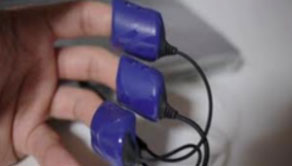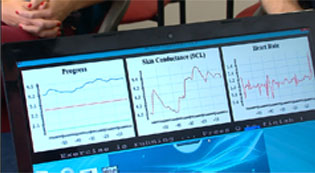SCIENTIFIC BACKGROUND
How does biofeedback therapy work?
Researchers aren't exactly sure how or why biofeedback works. They do know that biofeedback promotes relaxation, which can help relieve a number of conditions that are related to stress. During a biofeedback session, electrodes are attached to your skin. These electrodes send signals to a monitor, which displays a sound, flash of light, or image that represents your heart and breathing rate, blood pressure, skin temperature, sweating, or muscle activity.When you're under stress, these functions change. Your heart rate speeds up, your muscles tighten, your blood pressure rises, you start to sweat, and your breathing quickens. You can see these stress responses as they happen on the monitor, and then get immediate feedback as you try to stop them.
A biofeedback therapist helps you practice relaxation exercises, which you fine-tune to control different body functions. For example, you might use a relaxation technique to turn down the brainwaves that activate when you have a headache.
Several different relaxation exercises are used in biofeedback therapy, including:
• Deep breathing
• Progressive muscle relaxation -- alternately tightening and then relaxing different muscle groups
• Guided imagery -- concentrating on a specific image (such as the color and texture of an orange)
to focus your mind and make you feel more relaxed
• Mindfulness meditation -- focusing your thoughts and letting go of negative emotions
• Progressive muscle relaxation -- alternately tightening and then relaxing different muscle groups
• Guided imagery -- concentrating on a specific image (such as the color and texture of an orange)
to focus your mind and make you feel more relaxed
• Mindfulness meditation -- focusing your thoughts and letting go of negative emotions

As you slow your heart rate, lower your blood pressure, and ease muscle tension, you'll get instant feedback on the screen. Eventually you'll learn how control these functions on your own, without the biofeedback equipment. Different types of biofeedback are used to monitor different body functions: Electromyogram (EMG). This measures muscle activity and tension. It may be used for back pain, headaches, anxiety disorders, muscle retraining after injury, and incontinence.
Thermal. This measures skin temperature. It may be used for headache and Raynaud's disease.
Neurofeedback or electroencephalography (EEG). This measures brain waves. It may be used for attention deficit hyperactivity disorder (ADHD), epilepsy and other seizure disorders.
Electrodermal activity (EDA). This measures sweating and can be used for pain and anxiety.
Heart rate variability (HRA). This measures heart rate. It may be used for anxiety, asthma, chronic obstructive pulmonary disease (COPD), and irregular heartbeat.
Each biofeedback therapy section lasts about 30 minutes. Usually, you can start to see biofeedback benefits within 10 sessions or less. Some conditions, such as high blood pressure, can take 20 or more sessions to improve.
WebMD Posted: January 23, 201
Thermal. This measures skin temperature. It may be used for headache and Raynaud's disease.
Neurofeedback or electroencephalography (EEG). This measures brain waves. It may be used for attention deficit hyperactivity disorder (ADHD), epilepsy and other seizure disorders.
Electrodermal activity (EDA). This measures sweating and can be used for pain and anxiety.
Heart rate variability (HRA). This measures heart rate. It may be used for anxiety, asthma, chronic obstructive pulmonary disease (COPD), and irregular heartbeat.
Each biofeedback therapy section lasts about 30 minutes. Usually, you can start to see biofeedback benefits within 10 sessions or less. Some conditions, such as high blood pressure, can take 20 or more sessions to improve.
WebMD Posted: January 23, 201
NATIONAL INSTITUTE OF MENTAL HEALTH- Division of Scientific and Public
Information-Plain Talk Series- Ruth Kay, Editor
Information-Plain Talk Series- Ruth Kay, Editor
What is Biofeedback?
Biofeedback is a treatment technique in which people are trained to improve their health by using signals from
their own bodies. Physical therapists use biofeedback to help stroke victims regain movement in paralyzed
muscles. Psychologists use it to help tense and anxious clients learn to relax. Specialists in many different
fields use biofeedback to help their patients cope with pain.Chances are you have used biofeedback yourself. You've used it if you have ever taken your temperature or stepped on a scale. The thermometer tells you whether you're running a fever, the scale whether you've gained weight. Both devices "feed back" information about your body's condition. Armed with this information, you can take steps you've learned to improve the condition. When you're running a fever, you go to bed and drink plenty of fluids. When you've gained weight, you resolve to eat less and sometimes you do.





 Copyright © 2016 Stressfreecom
Copyright © 2016 Stressfreecom